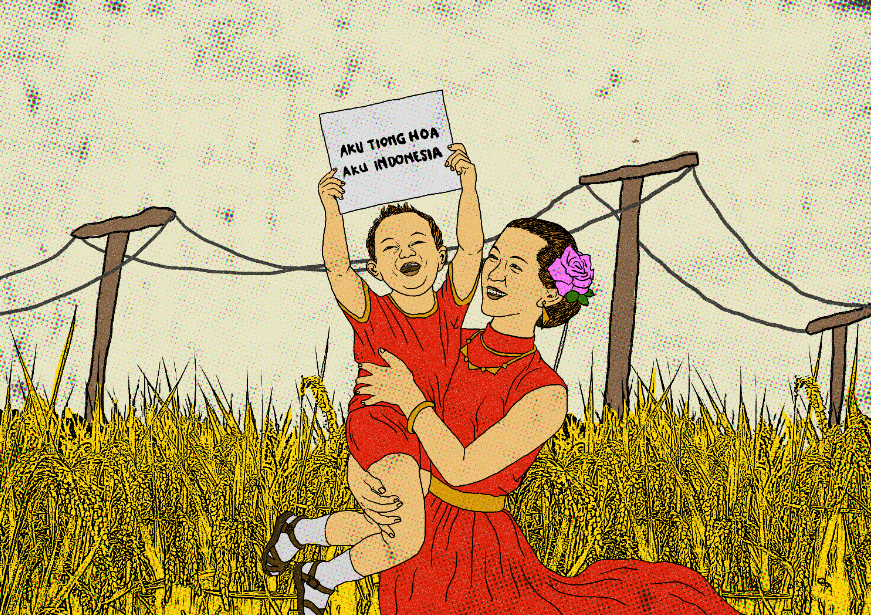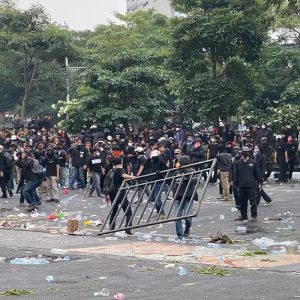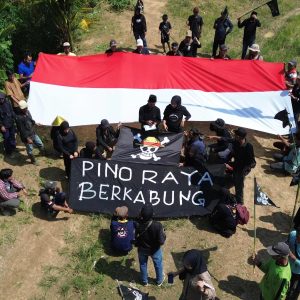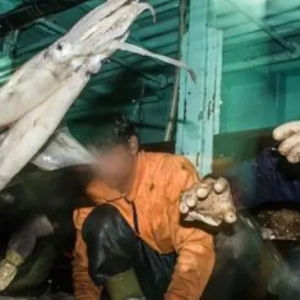Illustration: Jonpey
ON OCTOBER 9, 1998 Ita Martadinata was found dead in her house. During the investigation, the coroner found around 10 stab wounds all over her body. Martadinata’s head was nearly decapitated and a wooden stick was found inside her rectum. The assassination took place when she was about to leave the country to testify before a UN commission in her capacity as witness and survivor to mass rape of hundreds of women during the Jakarta’s deadly 1998 riot. She was only 18.
In the same year, a man saw a big break amidst the Asian economic crisis. Having made investments in a number of companies, the then 33-year-old baron amassed huge fortune out of series of merger and acquisition. Years after the downfall of Suharto, he became the epitome of Indonesia’s new breed of capitalist class. This is the story of the notorious Hary Tanoesoedibjo. He goes by Hary Tanoe. Sometimes HT.
In 1997, Tanoe’s company Bhakti Investama (BHIT)—later renamed MNC Investama—listed its initial public offering (IPO).
A year later, the bullets were no longer shy. In March 1998, a number of pro-democracy activists were kidnapped—some never returned. Less than three months later, a riot broke out in Jakarta. The looters targeted shopping malls and Chinese-owned businesses. Hundreds of women (mainly of Chinese descent) were raped.
Both Ita Martadinata and Hary Tanoe belong to Chinese-Indonesian community. Alas, they did not share the same story. She has been tragically and undeservedly forgotten, while he continues to accumulate wealth, rubbing shoulders with the new political class and eventually joining them.
Yet, the “Crazy Rich Chinese” (“Cina kaya”) stigma sticks forever as an index not only to the members of Chinese community that appeared to be wealthy, but to all Chinese-Indonesians regardless their diverse economic status.
It is a grave mistake to accusing all Chinese-Indonesians of being filthy rich. Chinese-Indonesians are by and large traders by profession but it does not make them belong to the same club as Hary Tanoe or Lippo’s Mochtar Riady, not to mention that a great deal of them chose to stayed away from commerce and turned to political activism. The popular image of “Crazy Rich Chinese”, if anything, is best understood as a social construct.
Centuries ago, overseas commerce brought Chinese people from present-day mainland China to mingle with the locals under Nusantara polities. The new immigrants, as noted by the Chinese voyager Ma Huan, erected settlements and constituted one of the three main social groups in the Majapahit kingdom. Nevertheless, hundreds of years later when the Dutch came to rule, the same people became the subject of discriminatory policies. Dutch racism, nevertheless, was far from isolated. Some local leaders who fought against the Dutch (including those dearly commemorated in the national pantheon as “heroes”) espoused some forms of racism against the Chinese. One of the them was the Prince Diponegoro. While Diponegoro was initially no xenophobic, his loss at the Battle of Gowokan led him to take the blame on a Chinese lady who gave him a massage a night earlier.
Dutch authorities made the Chinese their “middlemen” while consigning the locals (bumiputera/pribumi) to the bottom rung of society. Predictably, conflicts between the Chinese and the bumiputera gradually emerged, giving their colonial masters a leeway to exploit more lands, more natural resources, more population. Ordered by the Dutch to collect taxes, the Chinese (now classified as “Vreemde Oosterlingen” or “Foreign Orientals”) were often depicted as cunning, opportunistic, and self-aggrandizing. In fact, the job had since granted them the irredeemable image of “Dutch accomplices”. Thanks to the still-popular image, Chinese community routinely bore the brunt of violent crimes such as robbery, looting, and murder.
That doesn not mean that the Chinese accepted their fate. The Geger Pecinan massacre was a prominent example of a brutal suppression of Chinese uprising in the Dutch-Indies. In 1740, Batavia (now Jakarta) saw malaria outbreak and a drop in sugar prices. As a response, Dutch authorities demanded every person of Chinese descent to obtain a free-malaria document otherwise they would face deportation. They blackmailed those who had been in need of protection when anger was brewing at the other side of the town. There was a growing perception among the natives that they were massively impoverished while the Chinese were getting richer.
As a matter of fact, many local Chinese were exploited by the Dutch and in Chinese-owned sugar factories. While the wealthy Chinese just got richer by running sugar and liquor businesses, their Dutch compatriots lined their pockets through sugar speculation. However, the export commodity so cherished by the Dutch began to cause financial problems in 1740.
That the Chinese would rise in arms was initially unthinkable for the Dutch. However, shortly after the killing of around fifty Dutch soldiers by local surgar factory workers, virulent anti-Chinese propaganda began to spread like wildfire. Chinese laborers were falsely accused of raping, killing, and enslaving the natives. Chinese settlements quickly became the target of arson by bumiputera—who feared of their own safety—and Dutch cannons.
Many Chinese were burned to death inside their houses or shot dead in their attempts to flee. Meanwhile, the Dutch dispatched several boats full of army soldiers to exterminate the remaining survivors who fled to the canals. Some others were dragged out of medical wards only to be maimed and killed. The Dutch-Indies Council even provoked various ethnic groups to participate in the atrocities. Those surviving fire and bullets ended up butchered by local bandits. An approximate of 10,000 lives lost in the slaughter.
The massacre, the looting and property seizure of the Chinese in Batavia were the order of the day.
A few years after the pogrom, the Dutch established a Chinatown in Glodok area and introduced a stricter surveillance to the Chinese kampong. Those wanting to leave the ghetto required a special ticket. Nevertheless, many showed defiance and moved to different areas to rejoin the locals. The integration later served as the basis for multi-ethnic uprising organized by the Mataram’s Chinese-Javanese joint militia groups against the Dutch.
Permanent White Terror
After all, hatred against the Chinese survived throughout the 20th century—even to this day. Chinese-Indonesians were lynched in riots in Solo (1912) and Kudus (1918) and massacred during the national revolution (1945-1949). The newly-freed Indonesia saw the rise of anti-Chinese sentiments in Tangerang (1946), Bagan Siapi-api (1946), and Palembang (1947).
The hard-fought Indonesian independence did not naturally translate into the freedom from persecutions for the Chinese-Indonesians. In fact, the Sukarno years saw discriminatory laws against the Chinese. The Executive Order (Peraturan Presiden) No. 10 of 1959, for example, prohibited “foreigners” from conducting retail business at the district level, forcing the latter to hand over their enterprises to “Indonesian citizens” (meaning “the natives”, bumiputera). The decree had effectively led the Chinese (with or without Indonesian citizenship) to emigrate to China. In the same year, a race riot broke out in Cibadak, Bandung, West Java, following the implementation of the decree by local military command.
The Indonesian Citizenship Consultative Body (Baperki) was founded on 13 March 1954 as a civic organization campaigning for equal citizenship to Indonesian Chinese. Among its high profile members were the anti-colonial activist Siauw Giok Tjhan, legal scholar Yap Thiem Hien, and newspaper publisher P.K. Ojong. Despite the diversity of political views among members, Baperki’s policies endorsed acculturation of Chinese-Indonesian citizens to prevent disappearance of their culture.
In contrast to Baperki campaign, the National Unity Development Institute (LPKB), founded on 12 March 1963, championed the idea of assimilating Chinese-Indonesians to the bumiputera majority by abandoning their traditional customs and names.
Some of LPKB prominent figures were Harry Tjan Silalahi (who later co-found New Order’s brain trust Center for Strategic and International Studies/CSIS), Catholic activist Kristoforus Sindhunata, student activist Soe Hok Gie, and journalist Jakob Oetama.
Yet, the historic social and political contributions of Chinese-Indonesians are barely mentioned in Indonesian popular history. As a people, they are treated like fragrant blooms whenever they are needed and stinking plants when they not. Intellectual giants such as Siauw Giok Tjhan, state minister Oei Tjoe Tat, left-wing activist Tan Swie Ling, Tio Oen Bik (a republican volunteer in the Spanish Civil War) or Oey Hay Djoen (who translated Karl Marx’s Capital into Indonesian) are rarely heard of today—let alone during the New Order.
Suharto’s murderous regime, founded upon the white terror against Sukarno, did everything in its power to banish Chinese people from Indonesia’s political memory, reducing their role as mere traders and tycoons. In the wake of the 1965 anti-communist massacre, Baperki was classified as communist front organization and its members were slaughtered or rot in prisons. The socialist Siauw Giok Tjhan was imprisoned along with Oei Tjoe Tat, an ardent supporter of Sukarno. But others were not as lucky as Siauw and Oei. Accused of being communist spies, thousands of Chinese-Indonesians were killed in the 1965-1966 white terror.
For more than three decades, Suharto’s Neue Ordnung treated Chinese-Indonesians as cash cows. Indonesian tycoons of Chinese descent, as Christian Chua demonstrates in Chinese Big Business in Indonesia: The State of Capital (2008), did wield capital but not political power as they continued to be perceived as alien to Indonesian society.
Suppressing efforts to combat racism and discriminatory practices, Suharto’s terrorist government had effectively silenced Chinese-Indonesian voices. Racist laws including the Indonesian Citizenship Certificate (SKBRI) had successfully made Chinese-Indonesians question their identity. While they were forced to assimilate by abandoning their cultural roots, Chinese people were not allowed to integrate. The regime strictly prohibited Chinese New Year celebration, the use of Chinese language, and Confucianism. In fact, Suharto’s ‘assimilation’ policies relied on the long-standing assumption that Chinese culture was completely foreign to Indonesia, or that they made no effort to mingle with the pribumi, or that they were closeted communists. In short, the New Order had for years politically disempowered Chinese-Indonesians and made sure that they would not be able to organize. Therefore, the only available way to fight back was to keep playing the role of “Crazy Rich Chinese-Indonesians”.
And stay quiet.
As a result, discriminatory policies against the Chinese made issues related to social inequalities articulated in racial terms. Class conflict was—and in many cases still is—perceived as a social strife between different ethnic groups as later attested in May 1998. The rioting masses targeted “Cina” (a racist slur toward Chinese-Indonesian) instead of Suharto’s corrupt government or the capitalist class in general. Chinese-Indonesians, regardless of their economic status, were considered cukong (“big money”). Worst of all, the rape of Chinese-Indonesian women in the riot had created the impression that each and every Chinese-Indonesian deserved a grave punishment for their perceived status they were born into.
Suharto’s reign of terror has ended for more than two decades now, but the popular belief that “all Chinese-Indonesians are rich” is here to stay. Some Chinese-Indonesian capitalists had admittedly played a substantial role in shaping such perception.
As if the Geger Pecinan never happened, they thought nothing was wrong with labour exploitation in which they participated. And as if Geger Pecinan were a dress rehearsal for May 1998, in 1740’s Jakarta, the Chinese one-percenters could afford to escape the carnage by paying bribes to authorities, leaving their poor neighbors in the hands of their executioners.
It goes without saying that wealthy Chinese-Indonesians possess more privileges that any ordinary Chinese-Indonesians lack of. Many of the former, in 1998, fled to neighboring countries, leaving the latter haunted by fear and endless threats of persecution. It was business as usual for them once the riot was over. On the other hand, the deadly riot hit Chinese small traders hardest that they had to rebuild their businesses from scratch.
Racism has for a long time distracted our attention from class conflict. That is why seeing Hary Tanoe or Lippo’s Mohtar Riady as “Crazy Rich Chinese-Indonesians” will contribute nothing to the betterment of society. It would only entrench racist prejudices while keeping us away from dealing with the core problems, namely class society.
After centuries of capital and state oppression, true Chinese-Indonesians are not those who embrace ultra-nationalism (“NKRI Harga Mati”), neither those aspiring to exploit the downtrodden for the sake of profit. True Chinese-Indonesians throw their bodies to the barricades to combat racism and capitalism wherever they exist.
It’s time not to let Hary Tanoe or Mochtar Riady represent us. It’s time for us to rejoice the legacy of Ita Martadinata, Yap Thiem Hien, Siauw Giok Tjhan, Soe Hok Gie, and many others. While they radically belong to different political persuasions, they tirelessly fought for a better society, for the common good, for the rights of all people to live with dignity and justice.
“If you are looking to win a legal case,” said Yap in one occasion, “you are not picking me up as your attorney as we will undoubtedly lose. But, if you think it’s enough for you to speak the truth, then let me be your attorney”.
Chinese-Indonesians have for centuries swallowed the bitter truth of racism and capitalism. A fight against racism everywhere should now be about the fight to abolish the tyranny of capital over our very existence. As capital has no ethnicity, race, or religion, yet continues to divide workers into boundless categories of identity, anti-racist struggle without abolition of classes will amount to nothing but pipe dreams. ***
Sadina Palastri is a writer
The original article was written in Indonesian and published in IndoPROGRESS in June 21, 2020 (link).






